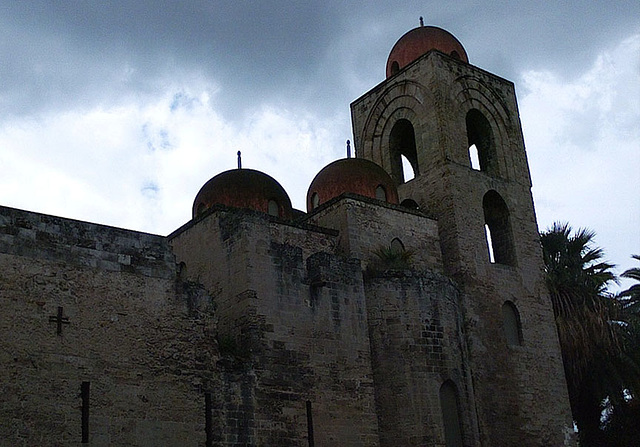The Church of St. John of the Hermits in Palermo,…
The Church of St. John of the Hermits in Palermo,…
The Cloister in St. John of the Hermits in Palermo…
The Cloister in St. John of the Hermits in Palermo…
La Cuba, a Medieval Castle in Palermo, March 2005
The Exterior of the Cathedral of Monreale, 2005
Street Leading to the Apse of the Duomo (Cathedral…
The Belltower of the Cathedral of Monreale, 2005
The Cloister Behind the Cathedral of Monreale, 200…
The Tomb of William II in the Duomo of Monreale, M…
Interior Courtyard Inside the Norman Palace in Pal…
Exterior of the Norman Palace in Palermo, March 20…
The Duomo, or Cathedral of Palermo, March 2005
The Duomo, or Cathedral of Palermo, March 2005
Detail of the Norman Mosaic in La Zisa, a Medieval…
Detail of the Norman Mosaic in La Zisa, a Medieval…
Detail of the Norman Mosaic in La Zisa, a Medieval…
Norman Mosaic and Fountain in La Zisa, a Medieval…
Norman Mosaic and Fountain in La Zisa, a Medieval…
Norman Mosaic and Fountain in La Zisa, a Medieval…
Remains of the Pond in from of La Zisa, a Medieval…
La Zisa, a Medieval Castle in Palermo, March 2005
Detail of La Zisa, a Medieval Castle in Palermo, M…
La Zisa, a Medieval Castle in Palermo, March 2005
La Zisa, a Medieval Castle in Palermo, March 2005
The Remains(?) of Columns from the Convent of La M…
The Church of La Martorana in Palermo, March 2005
The Church of La Martorana in Palermo, March 2005
The Belltower of Church of La Martorana in Palermo…
The Church of La Martorana in Palermo, March 2005
The Church of La Martorana in Palermo, March 2005
The Belltower of Church of La Martorana in Palermo…
The Belltower of Church of La Martorana in Palermo…
Sign in front of the Church of La Martorana in Pal…
The Church of San Cataldo in Palermo, March 2005
The Church of San Cataldo in Palermo, March 2005
Keywords
Authorizations, license
-
Visible by: Everyone -
All rights reserved
-
370 visits
The Church of St. John of the Hermits in Palermo, March 2005


San Giovanni degli Eremiti (St. John of the Hermits) is a church in Palermo, near the Palazzo dei Normanni.
The church's origin date to the 6th century. Later, after the Islamic conquest of Sicily, it was turned into a mosque. After the establishment of the Norman domination of southern Italy, it was returned to the Christian cult by Roger II of Sicily who, around 1136, entrusted it to the monks of St. William from Vercelli.
The church was extensively modified during the following centuries. A restoration held around 1880 attempted to restore its original medieval appearance.
The church is notable for its brilliant red domes, which show clearly the persistence of Arab influences in Sicily at the time of its reconstruction in the 12th century. In his Diary of an Idle Woman in Sicily, F. Elliot described it as "... totally oriental... it would fit well in Baghdad or Damascus". The bell tower, with four orders of arcaded loggias, is instead a typical example of Gothic architecture.
The church lies with a flank on a square construction, which probably a former mosque. The church is on the Latin Cross plan with a nave and two aisles and three apses. Each of the square spans is surmounted by a dome. The presbytery, ending with a niche, has also a dome.
The cloister, enriched by a luxurious garden, is the best preserved part of the ancient monastery. It has notable small double columns with capitals decorated by vegetable motifs, which support ogival arches. It also includes an Arab cistern.
Retrieved from "en.wikipedia.org/wiki/San_Giovanni_degli_Eremiti"
The church's origin date to the 6th century. Later, after the Islamic conquest of Sicily, it was turned into a mosque. After the establishment of the Norman domination of southern Italy, it was returned to the Christian cult by Roger II of Sicily who, around 1136, entrusted it to the monks of St. William from Vercelli.
The church was extensively modified during the following centuries. A restoration held around 1880 attempted to restore its original medieval appearance.
The church is notable for its brilliant red domes, which show clearly the persistence of Arab influences in Sicily at the time of its reconstruction in the 12th century. In his Diary of an Idle Woman in Sicily, F. Elliot described it as "... totally oriental... it would fit well in Baghdad or Damascus". The bell tower, with four orders of arcaded loggias, is instead a typical example of Gothic architecture.
The church lies with a flank on a square construction, which probably a former mosque. The church is on the Latin Cross plan with a nave and two aisles and three apses. Each of the square spans is surmounted by a dome. The presbytery, ending with a niche, has also a dome.
The cloister, enriched by a luxurious garden, is the best preserved part of the ancient monastery. It has notable small double columns with capitals decorated by vegetable motifs, which support ogival arches. It also includes an Arab cistern.
Retrieved from "en.wikipedia.org/wiki/San_Giovanni_degli_Eremiti"
- Keyboard shortcuts:
Jump to top
RSS feed- Latest comments - Subscribe to the comment feeds of this photo
- ipernity © 2007-2024
- Help & Contact
|
Club news
|
About ipernity
|
History |
ipernity Club & Prices |
Guide of good conduct
Donate | Group guidelines | Privacy policy | Terms of use | Statutes | In memoria -
Facebook
Twitter

Sign-in to write a comment.